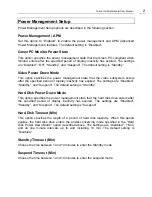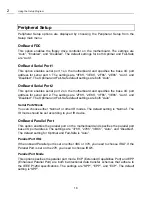
Yukon HX Motherboard User Manual
2
PCI IDE BusMaster
Set this option to “Enabled” to specify that the IDE controller on the PCI local bus has
bus mastering capability. The settings are “Disabled” and “Enabled”. The default
settings for both Optimal and Fail-Safe are “Disabled”.
Onboard SCSI (Optional)
Choose “Disabled” or “Enabled”. Choose “Enabled” to use onboard SCSI. The default
setting is “Enabled”.
Assign IRQ to PCI VGA Card
Assign IRQ to PCI VGA card. Choose either “Yes” or “No”. The default setting is “Yes”.
PCI Slot1 IRQ Priority, PCI Slot2 IRQ Priority, PCI Slot3 IRQ Priority,
PCI Slot4 IRQ Priority
Choose Auto or one of the following IRQ location: IRQ3-5, 7, 9-12. This option allows
you to choose a IRQ for PCI slots. The default setting is “Auto”.
DMA channel 0 to 7
Choose either “PNP” or “ISA/EISA” setting. If your ISA card is not Plug and Play and
requires DMA, then choose “ISA/EISA” setting on the DMA channel that it uses. The
default setting is “PNP”.
IRQ3 -7, 9-11, 14-15
These options specify the bus that the named interrupt request lines (IRQs) are used.
These options allow you to specify IRQs for use by legacy ISA adapter cards.
They determine if AMIBIOS should remove an IRQ from the pool of available IRQs
passed to BIOS configurable devices. The available IRQ pool is determined by reading
the ESCD NVRAM. If more IRQs must be removed from the pool, the end user can use
these PCI/PnP Setup options to remove the IRQ by assigning the option to the
ISA/EISA setting. Onboard I/O is configurable by AMIBIOS. The IRQs used by onboard
I/O are configured as PCI/PnP. The settings are “PCI/PNP” and “ “ISA/EISA”. The
default setting for both Optimal and Fail-Safe is “PCI/PnP”.
















































